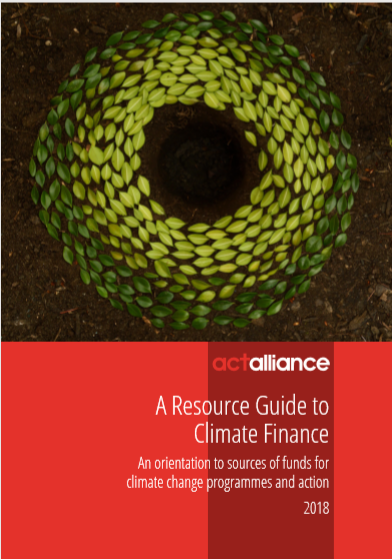A Resource Guide to Climate Finance: An orientation to sources of funds for climate change programmes and action

This Guide aims to provide an initial orientation to the available funds that may be relevant for financing climate-related programs and projects of ACT Forums, members and partners, as well as other Faith-Based Organisations (FBOs), NonGovernmental Organizations (NGOs), and public institutions in developing countries.
For this purpose, a wide range of possible donors of climate finance has been screened, covering various windows of the global climate finance architecture. To begin, the first window includes multilateral institutions, i.e. UNFCCC-related financial institutions like the Green Climate Fund and non-UNFCCC-related funds, as for example those established by multilateral development banks or UN programs. Many of these funds are relatively large, and well known, but are not necessarily easily accessible to the ACT Alliance membership. This is particularly true for the Green Climate Fund, the ‘flagship fund’ of climate finance.
A second important funding window is bilateral climate finance with various budget lines from bilateral donors, mainly from developed countries including for instance the United Kingdom (UK), Germany and Japan. There are also other donors, including Abu Dhabi. For ACT Alliance and other FBOs, the Nordic Funds and agencies might be particularly relevant due to their strong focus on having civil society organisations as a recipient of funds.
A third window, which may be the most attractive for many ACT Alliance members, consists of a broad variety of non-governmental grants, including private foundations, and donor agencies within ACT. These funds, unlike many bilateral or multilateral funds, usually have a strong preference for civil society organisations.
The fourth and final window includes various national and regional funds from developing countries themselves.
In this Guide, a broad definition for climate finance is used, building on the UNFCCC understanding that, “climate finance refers to local, national or transnational financing, which may be drawn from public, private and alternative sources of financing. Climate finance is critical to addressing climate change because large-scale investments are required to significantly reduce emissions, notably in sectors that emit large quantities of greenhouse gases. Climate finance is equally important for adaptation, for which significant financial resources will be similarly required to allow countries to adapt to the adverse effects and reduce the impacts of climate change.
This broad definition might not serve the purpose of politically shaping the current debate on climate finance which focuses on developed countries and their performance to fulfil the Copenhagen pledge, and later the USD 100 billion goal by 2020 and beyond, as agreed to at COP21 in Paris. In addition, a policy analysis that would include investigating climate finance by criteria such as; new, additional (to official development assistance(ODA)), predictable, gender responsive, human-rights-based, transparent, accountable and adhering to the principles of climate justice is not provided in this Guide. Instead, this Guide is intended to serve a more practical purpose by identifying various climate funds, rather than conducting a political assessment of them. The funds presented are therefore not analysed or scored on how well they perform vis-à-vis the climate finance policy demands of ACT Alliance.
Accordingly, the purpose of this Guide is to explore the practical questions related to climate finance, such as; background and volume of funds, sectoral and regional focus, eligibility criteria, deadlines for calls (where known), contact details and a brief assessment of the relevance of certain funds for ACT Alliance members and other FBOs as grant-seekers. Where appropriate, specific funding windows for civil society are highlighted and further information can be accessed through the web links provided.
This Climate Finance Guide covers 25 multilateral, 16 bilateral, 13 private, 10 faith-based, 3 national and 1 regional grant provider, which may be accessible by ACT Alliance members and partners. There is a substantial pool of accessible climate finance sources, and it is worth taking the time to identify the most suitable funds, particularly if an organisation, or government seeks funding for a specific purpose. Only targeted applications, in line with the general approach, funding priorities, and eligibility criteria of grant providers have a chance to be considered favourably. The competition between applicants is usually very high.
After having identified potential donors, it is important that the applicant fulfils the respective climate finance readiness criteria of the funder. Applicants must be able to elaborate well written and innovative concept notes and applications, in line with the applicant’s particular strength or unique dimension. The unique selling point of each application must be striking, the relevance for the donor must be clear, result-oriented, convincing, and the proposed implementation strategy must be feasible.
While some of the funds described in this Guide have high eligibility criteria, which may overburden many ACT members and partners, other funds are more accessible, even for small, comparatively less institutionalised organizations with modest climate change project experience. In some cases, it might be useful to form consortiums or partnerships in order to apply for funding. In other cases, the most suitable entry point might be to first invest in one’s own institutional capacity in order to become eligible for climate finance. Some of the funds covered in this Guide offer capacitybuilding measures, technical advice or financial support to assist applicants to enhance their institutional capacity.
Information on the availability of funds, funder’s priorities, budget-lines, and the specific calls and deadlines needs to be updated constantly. Thus, it is recommended to carefully cross-check the information provided with the Fund of interest.
While the Guide covers many funds, it is far from presenting an exhaustive list of available and accessible climate finance. It is therefore recommended that you extend the search for appropriate climate funds beyond the scope of the funds presented in this Guide. The information provided on additional climate finance resources (literature, websites) at the end of the Guide may help in this regard.
- Publisher: ACT Alliance
- Author(s): Thomas Hirsch Download

